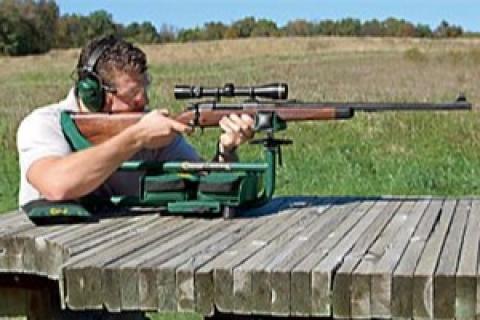
I once had my mouth washed out with soap for swearing, but I’m going to take a chance anyway and use the “F-word” today: flinch. There, I said it.
Flinching is probably the number one cause of poor shooting for most of us. In this two-part piece, we’ll examine what it is; what causes it; how to avoid it; how to recognize it; and how to get rid of it.
 |
| A shooting rest, like the Caldwell Lead Sled Plus Shooting Rest, can significantly help reduce recoil in rifles. |
Flinching is an uncontrolled pre-emptive movement in anticipation of recoil. Put more simply, it’s the fear of pain from recoil. It can take many forms, but the most common include some combination of closing your eyes before pulling the trigger, jerking rather than squeezing the trigger, or pulling your head or shoulder off the stock (which, ironically, will worsen the recoil). Some people are simply more sensitive to recoil than others.
Recoil is caused by shooting, perhaps excessively, guns that produce a lot of recoil. Over time, the punishment inflicted on the shooter causes the brain to react with fear to what is about to happen each time we pull the trigger.
As with many maladies, prevention is the best medicine. Here are some tips for avoiding developing a flinch.
- Don’t overdo it. When I go to the shooting range, I try to avoid shooting more than about a box of ammo for deer-class calibers, and about half of that for anything bigger. I also take my time and give myself a break between each shot. I’ll also try to take two or three rifles to the range each time, including at least one .22 rimfire or centerfire, or some other caliber with light recoil, and then rotate shooting between them all. By doing so you avoid taking too much punishment from any one gun, and developing any conditioned reactions.
- Protect yourself. There are myriad useful products designed to reduce “felt” or “perceived” recoil, but the two most fundamental are proper hearing protection and a good recoil pad. Not only do ear plugs or muffs of some sort perform their obvious function of preventing hearing loss, but reducing the noise of the report also helps reduce the fright factor. Although a metal butt plate or thin, hard-rubber pad may look nice on a rifle, they don’t do your shoulder any favors. A high-quality, modern recoil pad that is the right size for your gun will go a long way to preventing flinching and shoulder bruising. Recoil shields which slip on over your shooting shoulder can also help take the bite out of recoil.
- Gear up. I am a big fan of shooting rests and I simply don’t go to my shooting range without one. Not only do they give you a solid shooting platform, but many models also significantly reduce felt recoil. They allow me to comfortably shoot heavy calibers such as the .375 H&H, .416 Rigby and .458 Lott. I really notice the difference these devices make on the rare occasion when I shoot from a bench without the aid of such a rest.
- Mix it up. Although shooting from a bench is great for getting a rifle sighted-in properly, it is bad in terms of the punishment you feel from recoil. Seated behind a rifle in that way prevents the full body from rocking back to help absorb and spread out the recoil, leaving the shoulder to bear the full brunt. Once you’ve got your rifle dialed in, don’t just keep banging away. Instead, do the rest of your shooting from other shooting positions away from the bench. Not only will this help you prevent developing a flinch, but it’s good practice for hunting.
- Bigger isn’t always better. Avoid the temptation to “over gun”. You don’t really need the latest “.800 Maxi-Blaster” to take down a deer. Yes, high-velocity, flat-shooting, hard-hitting magnums can be an asset, but there is still no substitute for the ability to accurately place a well-constructed bullet where it needs to go. If you are afraid of your rifle, your ability to do so consistently will be greatly compromised.
In Part II, we’ll look at diagnosing and curing a flinch.
Good hunting.
- 4606 views

